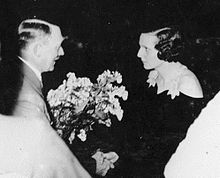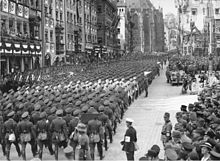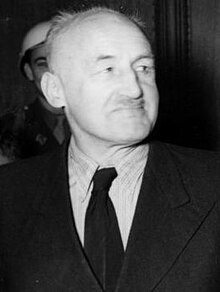Triumph of the Will
| Triumph of the Will | |
|---|---|
 German theatrical poster | |
| Directed by | Leni Riefenstahl |
| Written by |
|
| Produced by | Leni Riefenstahl |
| Starring | |
| Cinematography | |
| Edited by | Leni Riefenstahl (uncredited) |
| Music by | Herbert Windt |
Production company | Reichsparteitag-Film |
| Distributed by | UFA |
Release date |
|
Running time | 114 minutes |
| Country | Germany |
| Language | German |
Triumph of the Will (
Following its release in March 1935, it became a major example of film used as propaganda and was well-received at home. Riefenstahl's techniques—such as moving cameras, aerial photography, the use of long-focus lenses to create a distorted perspective, and the revolutionary approach to the use of music and cinematography—have earned Triumph of the Will recognition as one of the greatest propaganda films in history. It won several awards in Germany, France and Italy.[2]
During
Synopsis
The film begins with a prologue establishing the present-day as 5 September 1934 and the elapsed time since World War I, the Treaty of Versailles, Hitler's appointment as chancellor, climaxing in his visit to Nuremberg on that day. It is the only commentary in the entire film.
Day 1: The film opens with shots of the clouds above the city, and then moves through the clouds to float above the assembling masses below, with the intention of portraying beauty and majesty of the scene. The cruciform shadow of Hitler's plane is visible as it passes over the tiny figures marching below, accompanied by an orchestral arrangement of the Horst-Wessel-Lied. Upon arriving at the Nuremberg airport, Hitler and other Nazi leaders emerge from his plane to thunderous applause and a cheering crowd. He is then driven into Nuremberg, through equally enthusiastic people, to his hotel where a night rally is later held.
Day 2: The second day begins with images of Nuremberg at dawn, accompanied by an extract from the Act III Prelude (Wach Auf!) of
Day 3: The third day starts with a Hitler Youth rally on the parade ground. Again the camera covers the Nazi dignitaries arriving and the introduction of Hitler by Baldur von Schirach. Hitler then addresses the Youth, describing in militaristic terms how they must harden themselves and prepare for sacrifice. Everyone present, including General Werner von Blomberg, then assemble for a military pass and review, featuring Wehrmacht cavalry and various armored vehicles. That night Hitler delivers another speech to low-ranking party officials by torchlight, commemorating the first year since the Nazis took power and declaring that the party and state are one entity.
Day 4: The fourth day is the
Production

Riefenstahl, a popular German actress, had directed her first film called
The Victory of Faith faced numerous technical problems, including a lack of preparation (Riefenstahl reported having just a few days) and Hitler's apparent unease at being filmed.
In April 1934, Riefenstahl was commissioned by Hitler to create a successor film to The Victory of Faith.[12] Riefenstahl however, remained focused on production of her own film Tiefland (which was released only in 1954), while fellow director Walter Ruttmann worked on the party film. Ruttmann's ideals departed significantly from The Victory of Faith and sought to reorient the focus of the film onto the history of the Nazi movement rather than Hitler himself.[13] Hitler visited the studio on 6 December 1934 and permanently removed Ruttmann from the project, leaving Riefenstahl in sole control of what would become Triumph des Willens (Triumph of the Will).[14]
Filming

The film follows a similar design to The Victory of Faith, with the city of Nuremberg scenes, even to the shot of a cat, included in the city driving sequence in both films.[15] Herbert Windt reused much of his musical score from Victory of Faith, in Triumph des Willens, which he also scored.
Riefenstahl shot Triumph of the Will on a budget of roughly 280,000 RM (approximately US$110,000 in 1934, $1.54 m in 2015).[16] Extensive preparations were facilitated by the cooperation of party members, the military, and high-ranking Nazis like Goebbels. In 1975, Susan Sontag claimed that "The Rally was planned not only as a spectacular mass meeting, but as a spectacular propaganda film."[17]
Albert Speer, Hitler's personal architect, designed the set in Nuremberg and did most of the coordination for the event. Pits were dug in front of the speakers' platform so Riefenstahl could get the camera angles she wanted, and tracks were laid so that her cameramen could get traveling shots of the crowd. When the audio from rough cuts was not up to par, major party leaders and high-ranking public officials reenacted their speeches in a studio for her.[18]
Riefenstahl shot an estimated 61 hours of footage to create the two hour film.[19]
Reception
Triumph of the Will premiered on 28 March 1935 at the Berlin Ufa Palace Theater and was an instant success. Within two months the film had earned 815,000
The reception in other countries was not always as enthusiastic. British documentarian
One of the best ways to gauge the response to Triumph of the Will was the instant and lasting international fame it gave Riefenstahl.
Ethical controversy

Like American filmmaker
However, Roger Ebert has observed that for some, "the very absence of anti-semitism in Triumph of the Will looks like a calculation; excluding the central motif of almost all of Hitler's public speeches must have been a deliberate decision to make the film more efficient as propaganda."[30]
Riefenstahl said in 1964:
If you see this film again today you ascertain that it doesn't contain a single reconstructed scene. Everything in it is true. And it contains no tendentious commentary at all. It is history. A pure historical film ... it is
thesis, or, in the face of certain events, to let one thing go in order to accentuate another. I found myself, me, at the heart of an event which was the reality of a certain time and a certain place. My film is composed of what stemmed from that.[31]
However, Riefenstahl was an active participant in the rally, though in later years she downplayed her influence significantly, claiming, "I just observed and tried to film it well. The idea that I helped to plan it is downright absurd." Ebert states that Triumph of the Will is "by general consent [one] of the best documentaries ever made", but added that because it reflects the ideology of a movement regarded by many as evil, it poses "a classic question of the contest between art and morality: Is there such a thing as pure art, or does all art make a political statement?"[30] When reviewing the film for his "Great Movies" collection, Ebert reversed his opinion, characterizing his earlier conclusion as "the received opinion that the film is great but evil" and calling it "a terrible film, paralyzingly dull, simpleminded, overlong and not even 'manipulative', because it is too clumsy to manipulate anyone but a true believer".[32]
Writing in 1975,
Influences and legacy

Triumph of the Will remains well known for its striking visuals. As one historian notes, "many of the most enduring images of the [Nazi] regime and its leader derive from Riefenstahl's film."[34]
Extensive excerpts of the film were used in Erwin Leiser's documentary Mein Kampf, produced in Sweden in 1960. Riefenstahl unsuccessfully sued the Swedish production company Minerva-Film for copyright violation, although she did receive forty thousand marks in compensation from German and Austrian distributors of the film.[35]
In 1942, Charles A. Ridley of the
Charlie Chaplin's satire The Great Dictator (1940) was inspired in large part by Triumph of the Will.[38] Frank Capra used significant footage, with a mocking narration in the first installment of the propagandistic film produced by the United States Army Why We Fight as an exposure of Nazi militarism and totalitarianism to American soldiers and sailors.[39]
Copyright
Triumph of the Will remains in copyright. However, the film is commonly mistaken as belonging to the public domain, and it receives frequent unauthorized home video releases as a result.[40]
Germany
Riefenstahl filed lawsuits against two postwar documentaries which had incorporated footage of Triumph of the Will. The first lawsuit occurred in 1954 against Wolfgang Hartwig, producer of
In a judgement by the Federal Court of Justice on 29 December 1966, the copyright to the film was transferred to the Federal Republic of Germany as the legal successor of Nazi Germany.[44] These rights are administered by the federally owned Transit-Film GmbH based in Munich, although it was contractually regulated in 1974 that any public screening until 2004 had to be approved by Riefenstahl and that she received 70% of all revenues.[45]
United States
In 1996, the copyrights of the film were restored to Riefenstahl under the Uruguay Round Agreements Act,[46] although some aspect of the US copyrights are uncertain.[47]
See also
- The Birth of a Nation (1915 American film), which inspired the "second" KKK's formation
- List of German films of 1933–1945
- Nazism and cinema
Notes
- ^ See § External links for video
References
- ^ Barsam, Richard M (1975). Filmguide to Triumph of the Will. Bloomington, IN: Indiana University Press. p. 21.
- ^ Rother 2003, p. 71.
- ^ Hagopian, Kevin Jack. "Triumph of the Will – Film Notes". New York Writers Institute. University of Albany."When director Frank Capra was commissioned by the U.S. government to make what became the Why We Fight series of propaganda films in World War II, he screened a copy of Triumph of the Will which had been setd by the U.S. Customs office."
- ^ Julia Jacobs, Philipp Schepp: "Triumph des Willens". In: Thomas Hoeren, Lena Meyer: Verbotene Filme. Berlin 2007, p. 177. (In German.)
- JSTOR 1225104.
- ^ Rother 2003, p. 35.
- ^ Rother 2003, p. 51.
- JSTOR 3697138.(subscription required)
- ISBN 0-7492-8559-1.
- ^ Rother 2003, p. 55.
- ISBN 978-1-4668-2164-4. Retrieved 12 April 2020.
- ^ Rother 2003, p. 61.
- ^ Rother 2003, p. 62.
- ^ Rother 2003, p. 63.
- ^ Rother 2003, p. 58.
- ^ Barsam, Richard. "Filmguide to Triumph of the Will" (PDF). Retrieved 28 February 2015.
- ^ a b Sontag, Susan (6 February 1975). "Fascinating Fascism". The New York Review of Books.
- ISBN 978-0-316-09134-3.
- ^ "A perfect eye for mythology of the Nazis". The Sydney Morning Herald. 13 September 2003. Retrieved 10 September 2022.
- ^ Williams, Val (10 September 2003). "Leni Riefenstahl". Obituaries. The Independent. p. xx. Archived from the original on 30 August 2009.
- ISBN 0-306-80771-8. Retrieved 6 May 2012.
- ^ "Lambeth Walk – Nazi Style (1942)". The Public Domain Review. Retrieved 22 January 2019.
- ISBN 0-19-507898-5.
- ^ "Into Battle No. 4: These are the Men". Indiana University Bloomington. Retrieved 10 September 2022.
- ^ "Leni Riefenstahl: Hand-held history". The Economist. 11 September 2003.
- ^ Rising, David (9 September 2003). "Hitler's filmmaker Leni Riefenstahl, revered and reviled for her work, dies at 101". Associated Press.
- ^ Petropolous, Jonathan (11 September 2003). "Leni Riefenstahl, Coy Propagandist of the Nazi Era". The Wall Street Journal.
- ^ Riding, Alan (9 September 2003). "Leni Riefenstahl, Filmmaker and Nazi Propagandist, Dies at 101". The New York Times.
- ^ Harding, Luke (10 September 2003). "Leni Riefenstahl, Hitler's favourite film propagandist, dies at 101". The Guardian.
- ^ a b Ebert, Roger (24 June 1994). "The Wonderful Horrible Life of Leni Riefenstahl". Chicago Sun-Times.
- ISBN 978-0-307-27174-7.
- ^ Ebert, Roger (26 June 2008). "Triumph of the Will (1935)". Chicago Sun-Times. Archived from the original on 6 April 2011. Retrieved 12 September 2015.
- ^ Susan Sontag, "On Style," in Against Interpretation and Other Essays (New York: Dell Publishing Company/Laurel, 1969 [originally published by Farrar, Straus & Giroux, 1966]) pp. 34-35. In the 1969 paperback edition, she observes that she does not necessarily agree with all the positions expressed in the book's essays, though "when I wrote them, I believed what I wrote" (p. 6).
- ISBN 0-82647-390-3.
- ISBN 9780374184933.
- ^ "Nazis Hold Lambeth Walk is 'Animalistic Hopping'", The New York Times January 8, 1939, p. 26
- ^ "The Goofy, Anti-Nazi Parody Video That Enraged Goebbels". Slate magazine. 9 February 2016.
- ^ Trimborn, pp. 123–124.
- ^ Rollins, Peter C (ed.). (2003) “Indoctrination and Propaganda, 1942–1945” The Columbia companion to American history on film: How the movies have portrayed the American past. Columbia University Press. pp. 118.
- ^ Hall, Phil (21 August 2009). "The Bootleg Files: Triumph of the Will". Film Threat. Retrieved 28 February 2024.
- ^ Rother 2003, p. 148.
- ^ Rother 2003, p. 150.
- ^ Rother 2003, p. 149.
- ^ Meyer 2007, p. 179.
- ^ Meyer 2007, p. 184.
- ^ "Copyright Restoration of Works in Accordance With the Uruguay Round Agreements Act; Notice". Federal Register. 61: 46133–46159. 30 August 1996.
- ISSN 1041-6374. Retrieved 4 July 2020. (note 37)
Works cited
- Rother, Rainer (1 October 2003). Leni Riefenstahl: The Seduction of Genius. A&C Black. ISBN 9780826470232.
- Meyer, Lena (2007). Verbotene Filme (in German). Berlin: LIT Verlag Münster. ISBN 9783825801434.
Further reading
- Cheshire, Ellen (2000). "Leni Riefenstahl: Documentary Film-Maker Or Propagandist?". Kamera. Archived from the original on 17 December 2005.
- Kershaw, Ian (1987). ISBN 0-19-821964-4.
- Shirer, William. Berlin Diary: The Journal of a Foreign Correspondent 1934–1941. New York, Alfred A. Knopf, 1941. Includes a contemporary account of the 1934 Nuremberg rally.
- Smith, David Calvert (1990). Triumph of the Will: A Film by Leni Riefenstahl. Richardson, TX: Celluloid Chronicles Press. Archived from the original on 20 February 2002. (Complete screenplay.)
- Welch, David (1993). The Third Reich Politics and Propaganda. New Fetter Lane, London: Routledge. pp. 65–72. ISBN 0-415-09033-4.
External links
- Das Blaue Licht: Triumph des Willens (1935), the original Riefenstahl website
- Screenplay of Triumph of the Will, DasBlaueLicht.net
- Hinter den Kulissen des Reichsparteitag-Films, Riefenstahl's 1935 book on the making of the film with many photographs (in German)
- Triumph of the Will at IMDb
- Triumph of the Will at Rotten Tomatoes
